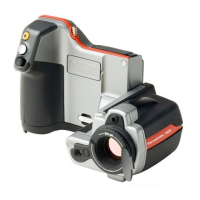used value of 0.1% of the building exposed surface area is generally accepted as the
maximum combined defect area allowable to comply with the Building Regulations.
This represents one square metre in every thousand.
27.3.8.4.4 Measuring surface temperature
Measurement of surface temperature is the function of the infrared imaging system.
The trained thermographer will recognise, account for and report on the variation of
emissivity and reflectivity of the surfaces under consideration.
27.3.8.4.5 Measuring area of the defects
Measurement of defect area can be performed by pixel counting in the thermal anal-
ysis software or most spreadhseet packages provided that:
■ the distance from camera to object is accurately measured probably using a laser
measurement system,
■ the target distance should take into account the IFOV of the imaging system,
■ any angular change between the camera and the object surface from the perpen-
dicular is accounted for.
Buildings consist of numerous construction features that are not conducive to quan-
titative surveys including windows, roof lights, luminaries, heat emitters, cooling
equipment, service pipes and electrical conductors. However, the joints and connec-
tions between these objects and the building envelope should be considered as part
of the survey.
27.3.8.5 Conditions and equipment
To achieve best results from a thermal insulation survey it is important to consider
the environmental conditions and to use the most appropriate thermographic technique
for the task.
Thermal anomalies will only present themselves to the thermographer where temper-
ature differences exist and environmental phenomena are accounted for. As a mini-
mum, the following conditions should be complied with:
■ Temperature differences across the building fabric to be greater than 10℃ (18℉).
■ Internal air to ambient air temperature difference to be greater than 5℃ (9℉) for
the last twentyfour hours before survey.
■ External air temperature to be within ±3℃ (±5.4℉) for duration of survey and for
the previous hour.
■ External air temperature to be within ±10℃ (±18℉) for the preceding twentyfour
hours.
In addition, external surveys should also comply with the following:
Publ. No. 1558792 Rev. a460 – ENGLISH (EN) – July 1, 2010 173
27 – Introduction to building thermography

